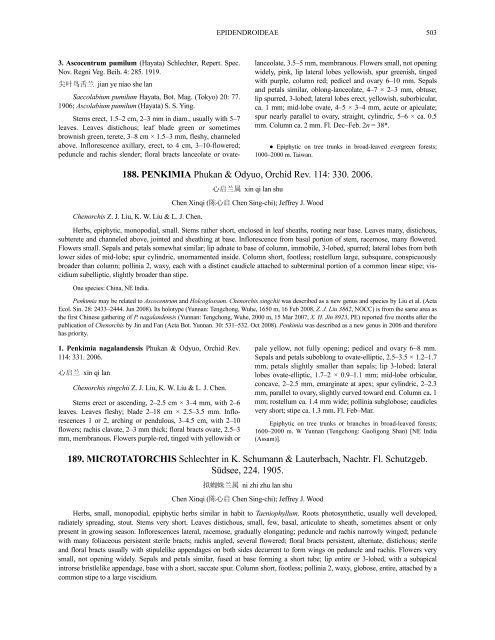You also want an ePaper? Increase the reach of your titles
YUMPU automatically turns print PDFs into web optimized ePapers that Google loves.
3. Ascocentrum pumilum (Hayata) Schlechter, Repert. Spec.<br />
Nov. Regni Veg. Beih. 4: 285. 1919.<br />
尖叶鸟舌兰 jian ye niao she lan<br />
Saccolabium pumilum Hayata, Bot. Mag. (Tokyo) 20: 77.<br />
1906; Ascolabium pumilum (Hayata) S. S. Ying.<br />
Stems erect, 1.5–2 cm, 2–3 mm in diam., usually with 5–7<br />
leaves. Leaves distichous; leaf blade green or sometimes<br />
brownish green, terete, 3–8 cm × 1.5–3 mm, fleshy, channeled<br />
above. Inflorescence axillary, erect, to 4 cm, 3–10-flowered;<br />
peduncle and rachis slender; floral bracts lanceolate or ovate-<br />
EPIDENDROIDEAE<br />
503<br />
lanceolate, 3.5–5 mm, membranous. Flowers small, not opening<br />
widely, pink, lip lateral lobes yellowish, spur greenish, tinged<br />
with purple, column red; pedicel and ovary 6–10 mm. Sepals<br />
and petals similar, oblong-lanceolate, 4–7 × 2–3 mm, obtuse;<br />
lip spurred, 3-lobed; lateral lobes erect, yellowish, suborbicular,<br />
ca. 1 mm; mid-lobe ovate, 4–5 × 3–4 mm, acute or apiculate;<br />
spur nearly parallel to ovary, straight, cylindric, 5–6 × ca. 0.5<br />
mm. Column ca. 2 mm. Fl. Dec–Feb. 2n = 38*.<br />
● Epiphytic on tree trunks in broad-leaved evergreen forests;<br />
1000–2000 m. Taiwan.<br />
188. PENKIMIA Phukan & Odyuo, Orchid Rev. 114: 330. 2006.<br />
Chenorchis Z. J. Liu, K. W. Liu & L. J. Chen.<br />
心启兰属 xin qi lan shu<br />
Chen Xinqi (陈心启 Chen Sing-chi); Jeffrey J. Wood<br />
Herbs, epiphytic, monopodial, small. Stems rather short, enclosed in leaf sheaths, rooting near base. Leaves many, distichous,<br />
subterete and channeled above, jointed and sheathing at base. Inflorescence from basal portion of stem, racemose, many flowered.<br />
Flowers small. Sepals and petals somewhat similar; lip adnate to base of column, immobile, 3-lobed, spurred; lateral lobes from both<br />
lower sides of mid-lobe; spur cylindric, unornamented inside. Column short, footless; rostellum large, subsquare, conspicuously<br />
broader than column; pollinia 2, waxy, each with a distinct caudicle attached to subterminal portion of a common linear stipe; viscidium<br />
subelliptic, slightly broader than stipe.<br />
One species: China, NE India.<br />
Penkimia may be related to Ascocentrum and Holcoglossum. Chenorchis singchii was described as a new genus and species by Liu et al. (Acta<br />
Ecol. Sin. 28: 2433–2444. Jun 2008). Its holotype (Yunnan: Tengchong, Wuhe, 1650 m, 16 Feb 2008, Z. J. Liu 3862, NOCC) is from the same area as<br />
the first Chinese gathering of P. nagalandensis (Yunnan: Tengchong, Wuhe, 2000 m, 15 Mar 2007, X. H. Jin 8923, PE) reported five months after the<br />
publication of Chenorchis by Jin and Fan (Acta Bot. Yunnan. 30: 531–532. Oct 2008). Penkimia was described as a new genus in 2006 and therefore<br />
has priority.<br />
1. Penkimia nagalandensis Phukan & Odyuo, Orchid Rev.<br />
114: 331. 2006.<br />
心启兰 xin qi lan<br />
Chenorchis singchii Z. J. Liu, K. W. Liu & L. J. Chen.<br />
Stems erect or ascending, 2–2.5 cm × 3–4 mm, with 2–6<br />
leaves. Leaves fleshy; blade 2–18 cm × 2.5–3.5 mm. Inflorescences<br />
1 or 2, arching or pendulous, 3–4.5 cm, with 2–10<br />
flowers; rachis clavate, 2–3 mm thick; floral bracts ovate, 2.5–3<br />
mm, membranous. Flowers purple-red, tinged with yellowish or<br />
pale yellow, not fully opening; pedicel and ovary 6–8 mm.<br />
Sepals and petals suboblong to ovate-elliptic, 2.5–3.5 × 1.2–1.7<br />
mm, petals slightly smaller than sepals; lip 3-lobed; lateral<br />
lobes ovate-elliptic, 1.7–2 × 0.9–1.1 mm; mid-lobe orbicular,<br />
concave, 2–2.5 mm, emarginate at apex; spur cylindric, 2–2.3<br />
mm, parallel to ovary, slightly curved toward end. Column ca. 1<br />
mm; rostellum ca. 1.4 mm wide; pollinia subglobose; caudicles<br />
very short; stipe ca. 1.3 mm. Fl. Feb–Mar.<br />
Epiphytic on tree trunks or branches in broad-leaved forests;<br />
1600–2000 m. W Yunnan (Tengchong: Gaoligong Shan) [NE India<br />
(Assam)].<br />
189. MICROTATORCHIS Schlechter in K. Schumann & Lauterbach, Nachtr. Fl. Schutzgeb.<br />
Südsee, 224. 1905.<br />
拟蜘蛛兰属 ni zhi zhu lan shu<br />
Chen Xinqi (陈心启 Chen Sing-chi); Jeffrey J. Wood<br />
Herbs, small, monopodial, epiphytic herbs similar in habit to Taeniophyllum. Roots photosynthetic, usually well developed,<br />
radiately spreading, stout. Stems very short. Leaves distichous, small, few, basal, articulate to sheath, sometimes absent or only<br />
present in growing season. Inflorescences lateral, racemose, gradually elongating; peduncle and rachis narrowly winged; peduncle<br />
with many foliaceous persistent sterile bracts; rachis angled, several flowered; floral bracts persistent, alternate, distichous; sterile<br />
and floral bracts usually with stipulelike appendages on both sides decurrent to form wings on peduncle and rachis. Flowers very<br />
small, not opening widely. Sepals and petals similar, fused at base forming a short tube; lip entire or 3-lobed, with a subapical<br />
introrse bristlelike appendage, base with a short, saccate spur. Column short, footless; pollinia 2, waxy, globose, entire, attached by a<br />
common stipe to a large viscidium.
















